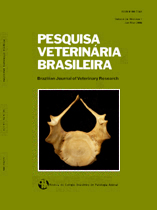 |
|
|
|
Year 2010 - Volume 30, Number 6
|

|
Determination of the basal metabolic rate in agoutis, Dasyprocta azarae, by indirect calorimetry, 30(6):471-478
|
ABSTRACT.- Brito H.F.V., Deconto I., Lange R.R. & Pachaly J.R. 2010. [Determination of the basal metabolic rate in agoutis, Dasyprocta azarae, by indirect calorimetry.] Determinação da taxa metabólica basal em cutias, Dasyprocta azarae, por calorimetria indireta. Pesquisa Veterinária Brasileira 30(6):471-478. Instituto Qualittas de Pós-Graduação, Rua Conde DEu 38, Campinas, SP 13100-009, Brazil. E-mail: haraldvet@yahoo.com.br
The best way to compare different organisms is the basal metabolic rate, a fundamental interrelation existent among all living beings. Direct measures of oxygen and carbon dioxide concentrations by evaluation of inspired and expired air can be used to measure metabolic rate. So, this research was done in order to measure basal and specific metabolic rates in agoutis (Dasyprocta azarae), and reexamine the scaling of basal metabolism in this species. There were used 34 adult healthy agoutis (9 non-castrated males, 9 castrated males, and 16 females), that belong to the wild animal scientific breeding facility of the Natural History Museum of the Curitiba city, State of Paraná, Brazil. After a six-hour fasting the animals were placed in special boxes under controlled temperature (22.0±1.0oC), and submitted to measuring of the basal metabolic rate, by indirect calorimetry. It was used the Deltatrac®II metabolic monitor, usually indicated to measure carbon dioxide production (VCO2) and oxygen consumption (VO2) in human beings, by measuring variations in the concentration of VCO2 and of VO2, with a precision of 0.01%. The specific metabolic rate was calculated after determination of the basal metabolic rate and the obtained data were analyzed by inductive statistics. The hypotheses tests for comparison among samples indicated that the specific metabolic rate is higher in non-castrated males than in females and castrated males (significance of 5%), and that the specific metabolic rate of females and castrated males are equivalent (significance of 1%). In addition, analysis of the correlation of experimental points indicates that another variable beyond body size affects the metabolic rate of non-castrated males (significance of 1%), and therefore new studies on the metabolism of Dasyprocta azarae are required. |
| |
|
|
| |
|
 |